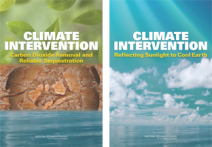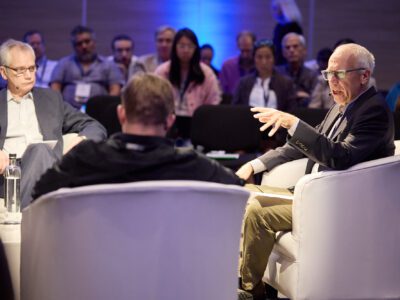Climate Engineering: National Academy Committee recommends starting research (with limits)
An NAS report on controversial engineered responses to climate change gets all the big things right, but avoids the hardest questions
Earlier this week, the National Research Council Committee on Geoengineering Climate released two reports, “Climate Intervention: Carbon Dioxide Removal and  Reliable Sequestration” and “Climate Intervention: Reflecting Sunlight to Cool Earth.”
Reliable Sequestration” and “Climate Intervention: Reflecting Sunlight to Cool Earth.”
Requested and funded by several US federal departments – NASA, NOAA, DOE, and the cutely labeled “U.S. Intelligence Community” – this report is the first time a National Academy committee has addressed these newly prominent, highly controversial potential responses to the looming, slow-motion, steadily-getting-worse threat of climate change. Chaired by Marcia McNutt, editor-in-chief of Science magazine and past director of the U.S. Geological Survey, the committee packed a ton of brainpower and experience – and they did, with a couple of exceptions, a very good job on a very hard and contentious topic.
To cut to the chase: The report got all the important things right, and made a substantial contribution simply by raising the prominence of these important and controversial issues and stamping them with the gravity of an NRC report. But they avoided the question, or spoke obscurely, on the hardest issues – all of which concern “what on Earth do we do with these things.”
Here are their main conclusions – in my words, with a bit of my own elaboration (Disclosure: I was not a member of the Committee, but was one of its peer-reviewers.)
- Emission cutting and adaptation are the first and most important responses to climate change, and need to proceed strongly and immediately. Get going, and never forget this. Nothing the Committee recommends about climate engineering undermines the importance of this.
- But even the best feasible action on emission cutting and adaptation would leave us facing serious remaining risks – and we are far far away from the best feasible action. The severe remaining risks call for investigating climate engineering, meaning active interventions in the Earth’s carbon cycle, and its radiation balance – because these things offer the prospect of large reductions in the risks we face, and we might find ourselves in such deep trouble that want/ need them – so we’d better start investigating now whether and how well they work, and what additional or novel risks they present.
(Aside on terminology: There’s a lot of useless argument over what to call this stuff. Standard usage is shifting from “geoengineering” toward “climate engineering” — sensibly, since it’s intentional global-scale manipulation of Earth systems not for any purpose, but to slow or stop destructive climate changes underway. The Committee rejects “climate engineering,” however, and instead proposes “climate intervention.” Their reasoning: Calling anything “engineering” implies we understand the system well enough to manipulate it with high confidence of results, and in this case we don’t. Fair enough: they’re certainly correct in their characterization of present knowledge, although I’m not completely convinced that “engineering” carries that meaning. As for the two major types of approaches within climate engineering, each has multiple proposed names, most of them clumsy and all of them being attacked for one reason or another. For today’s purposes (after considering and rejecting “Thing 1” and “Thing 2”), I will call them “Carbon stuff” and “Sunlight stuff.” - These two approaches are so different in their potential benefits and risks that they have to be considered separately. Carbon stuff looks pretty much like emission-cutting in reverse, except it comes with some disadvantages (it mostly costs more, and you need to worry about the long-term stability of where you put the carbon) and some advantages (It’s flexible in where, when, and at what scale you do it; and it holds the unique prospect of driving net human emissions negative, so it can, if deployed at big enough scale for long enough, move beyond slowing or stopping harm, to actually reversing some of the harm we’ve already done.) But carbon stuff, like conventional emission-cutting, can only work slloooowwlly. Intense, virtuous efforts starting today do nothing to limit near-term risks, but only start to deflect the curve of future climate change and associated risks after a delay of decades – something like 30 to 50 years, depending on just how hard we push. Sunlight stuff can slow or stop some (not all) risks from elevated greenhouse gases and climate-change fast – i.e., within a year or two – but it is only a partial solution and it carries a bunch of novel and imperfectly understood risks – some direct, but many related to its potential for misuse.
- Expanded research on both approaches should proceed – faster, less encumbered, and more aimed at operational capability for carbon stuff, and with more reservations, a limit to tiny scales of active perturbation with minimal direct risks, and (maybe) additional regulatory encumbrances for sunlight stuff.
None of these points is new or surprising, but the committee’s exploration of them is measured, cogent, and helpful – and having these things said by an NAS committee can make a big difference in getting attention to the topic and starting the conversation. Good job, committee!
My biggest problem with the report is that they mostly ducked the hardest and most contentious questions, particularly about governance of research. In particular, they are quite ambiguous on the sharply contested question of whether a new system of regulatory control needs to be in place before the first, smallest outdoor sunlight-stuff experiments take place.
My guess is that they will be read, on balance, as saying go ahead and take the next (small) step – outdoor field experiments, including small-scale active aerosol perturbations (both stratospheric and marine cloud brightening). But plenty of people will parse their text to claim they said the opposite, and the text is ambiguous enough to support both readings. With all the brain-power and resources they had, I wish they had not just issued yet another call for a “serious deliberative process” to consider these questions, but actually taken them forward a step or two.
What impact will the report have? My guess is that it has a good chance of moving the debate forward, mainly by getting research program managers and their bosses to start discussing concretely what specific research to fund, by what criteria, and under what (if any) additional oversight and control to address the related risks. On balance I think this would be a good outcome, but I worry about the possibility that these conversations take place exclusively in the United States, rather than immediately engaging international counterparts – which is an essential step toward managing the longer-term risks posed by these technologies, most of which are political, not technical.
The reports and associated materials from the National Academy of Sciences are here.
A very helpful compilation of press reactions and civil-society reactions to the Reports has been assembled by Michael Thompson at the “Forum for Climate Engineering Assessment.”
Reader Comments
2 Replies to “Climate Engineering: National Academy Committee recommends starting research (with limits)”
Comments are closed.







Ted said:
“……Emission cutting and adaptation are the first and most important responses to climate change, and need to proceed strongly and immediately…..”
Why is cutting carbon dioxide emissions so important? There is no conclusive and indisputable scientific proof that carbon dioxide is the driving force in climate change. Cutting emissions is a very expensive and dubious response that may not have any effect whatsoever in mitigating climate change. We need more research before jumping to conclusions.
Unless by “conclusive and indisputable proof” you mean some standard of utter certainty only available in mathematics and other purely formal systems — i.e., a standard of certainty that is *never* attained by science — then your claim is wrong. (I suspect you know this, since you don’t even bother trying to back it up.)
We know that CO2 and other infrared-absorbing gases are causing the recent unprecedented increases in global-average temperatures, and will cause continued increases, as well as we ever know anything in science.
We know this from the following lines of evidence:
1) basic infrared absorption spectra — these gases (and water vapor) absorb radiation at the wavelengths the Earth’s surface emits.
2) calculations of average heating — both from naturally occurring greenhouse gases and from human-driven increases (plus resultant feedbacks from water vapor) that have been approximately correct since the very first ones, done by hand more than 100 years ago.
3) Highly precise model replications of 20th-century climate change in which only observed increases in greenhouse gases can account for observed changes;
4) multiple characteristics of the pattern of changes we are seeing that provide a unique fingerprint of greenhouse-driven heating — including in particular the fact that the surface and lower atmosphere are getting hotter while the stratosphere is getting colder — a pattern that is consistent with heating from greenhouse gases but not from any other proposed cause (e.g., not consistent with observed changes being driven by solar fluctuations);
5) The utter, total failure of a bunch of really smart, well-funded people, to make *any* other explanation for observed recent changes pass the laugh test. No, it’s not the sun. It’s not some pattern of natural variability never before observed in the record of past climate fluctuations. It’s not fairy dust. Wait, let me correct that. I can’t *prove* that it’s not fairy dust, but no one has ever brought forward any evidence saying it is — and even if they did, they’d also have to show why the utterly well-known, massively demonstrated phenomenon of heating through infrared absorption by CO2 and other greenhouse gases is *not* happening the way we know it does.